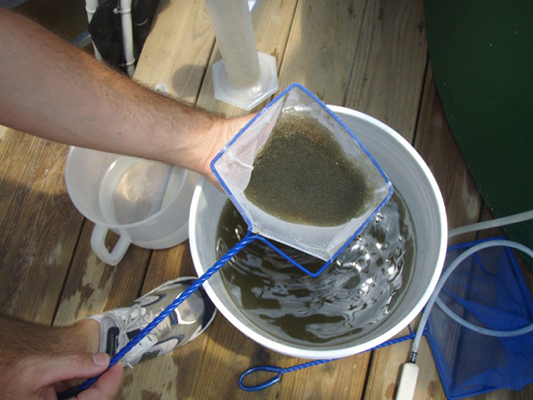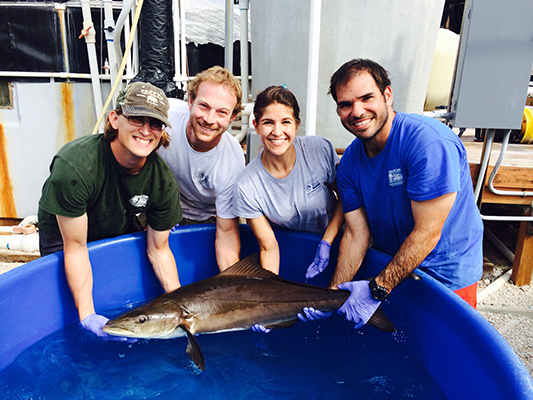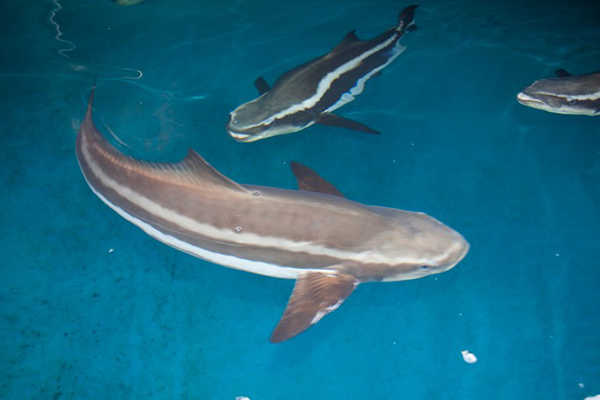Posted May 1, 2015
By S. MOLLY DOMINICK
According to The World Bank, nearly two-thirds of all fish sold in stores will be grown on fish farms by the year 2030.
But the fish farming industry experiences issues with consistent production. This is primarily due to the industry’s dependence upon the natural growth and development of fish, which often will not fulfill market demands naturally.
Click on the video above to view a slideshow about UM fish
hatchery research (by S. Molly Dominick).
The Experimental Marine Fish Hatchery at the University of Miami Rosenstiel School of Marine and Atmospheric Science (RSMAS), otherwise known as “the hatchery,” is conducting influential research to optimize the production process of fish farming for a more efficient industry.
The director of Aquaculture at RSMAS, Daniel Benetti, said that working toward the profitability and sustainability of fish farming are goals that operate hand-in-hand.
“We work with science and technology to optimize ecological and economic viability of fish farming,” he said, “Ultimately, we have to meet the bottom line which is to make money – business – but with an environmentally conscientious mind.”
The hatchery currently works with species of fish such as pompano, mahi mahi, grouper and cobia. Ongoing research is trying to find conditions that allow these fish to be available in markets year-round and grow to market-size as quickly as possible.
Some species of fish, such as cobia, naturally spawn only during warmer summer months. But a group of researchers including Benetti and John Stieglitz, who works at the hatchery, are working to induce cobia to spawn year-round.
Stieglitz explained that having year-round spawn is important in running a business.
“[Seasonal spawning] restricts the availability of eggs to only certain seasons, so there’s a seasonal break in your production cycle,” Stieglitz said. “So for a commercial facility, where markets would like to see product delivered on a weekly or bi-weekly basis, you want to have fish coming to market size, and ready for harvest on a steady schedule throughout the year.”
The researchers found that adjusting water temperatures can induce spawning even during the colder months, with warmer temperatures sending signals to fish that it’s time to reproduce.
“When the water temperatures rise, that puts them in the mood, so to speak,” Stieglitz said. “All of the animals are very in tune with these things in their environment, so these will trigger cascades of hormones inside their bodies that tell them this is their reproductive season.”
Once fish release their eggs, the hatchery sends their cobia eggs to Open Blue Sea Farms. This company, which provides funding to the hatchery, is located in Panama and is the largest producer of cobia in the world. Here, the eggs are grown into market-size fish and made ready for sale.

These cobia eggs were just fertilized and will be transferred to Open Blue Sea Farms in Panama for growth to market size (Photo courtesy of John Stieglitz).
Finding ways to grow fish to market size in a shorter period of time is another task taken on by the hatchery.
Most species of fish have different growth rates between males and females. In the case of cobia, females may grow to twice the size of males in one year, making production of females more preferable in the aquaculture industry.
For this reason, new research at the hatchery focuses on producing all-female populations. One project is testing the effect of temperature shocks in achieving this goal.
Temperature shocks may help determine gender during the embryonic stage, according to Benetti, so researchers are lowering water temperature by about ten degrees Celsius once eggs are fertilized.
“It is well-known with reptiles like crocodiles and turtles that, depending on the temperature the eggs are incubated in… there’s an all-female population or vice-versa,” Benetti said. “We’re assuming that with fish, it would be something similar.”
The work is still experimental, so Benetti said he can’t predict when the hatchery will begin to see results.
“That’s the thing with research; you never know,” Benetti said. “We could see progress tomorrow or in a year. That’s just the nature of what we’re doing. Of course, we would like to see results within a year, but it’s a complex project. First, you have to wait months to see if they all are female or not.”

Graduate students Zack Daughtery, Julian Fiorentino, and Christy Belfranin celebrate their work with fish growth alongside Carlos Tudelo (Photo by Daniel Benetti).
Other ongoing projects include work by graduate student Christina Belfranin to improve alternative methods of feeding carnivorous pompano fish. Soybean meal has proven to be an effective and less expensive substitute than the typical fish meal given to pompano, making it a good choice for commercial aquaculture facilities.
Belfranin is making adjustments to soybean meal to make sure it gives fish everything they require for good health by exploring the amino acid requirements for pompano. By doing so, Belfranin said that the industry can better learn what fish require at different stages of their lives and make feed that is cheaper but still lets fish grow to their optimal size.
“In general, the aquaculture industry needs money,” Belfranin said. “And if they can, they want to get fish to grow as much as they can and in the shortest time possible.”

